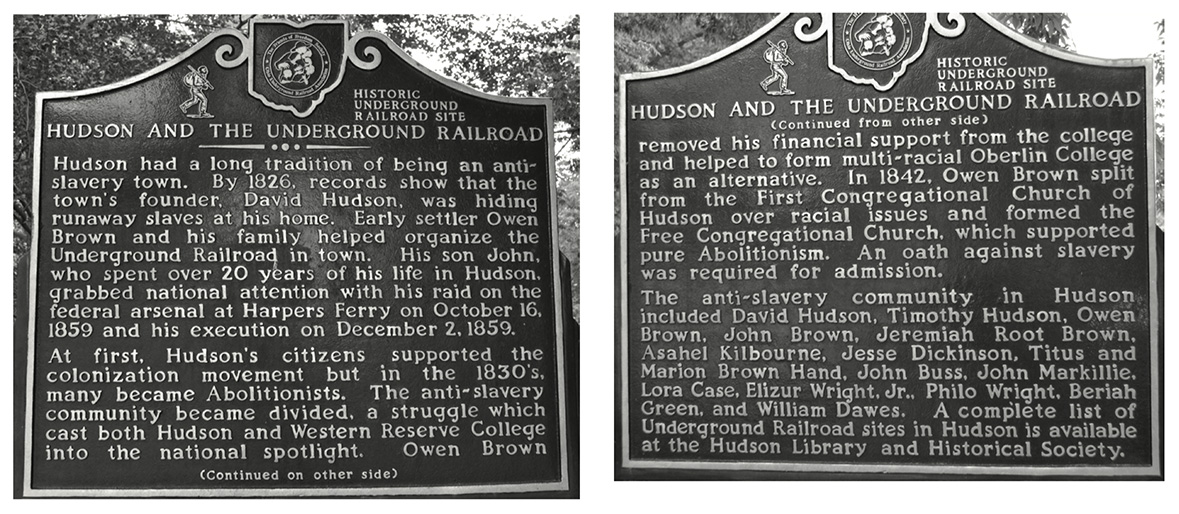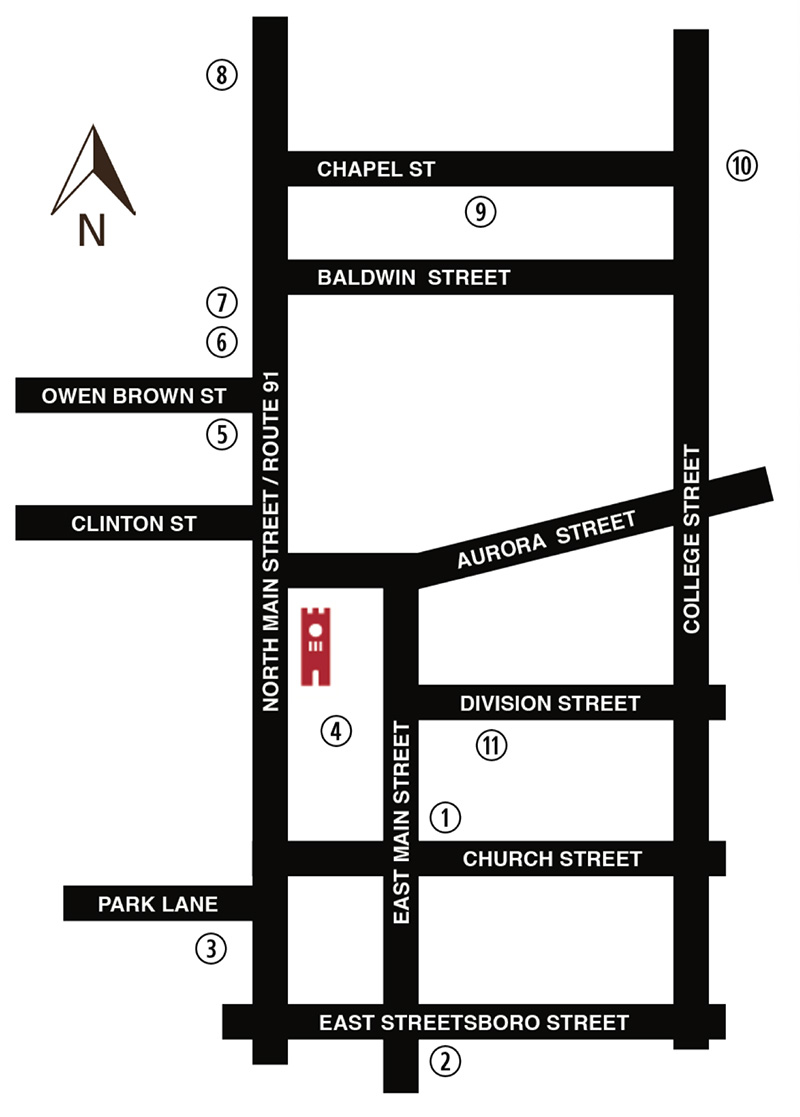NEXT MEETING: Thurs, April 10, 7:00pm at Barlow Community Center. Award-winning Hudson Author Joyce Dyer, brings new perspective to life of John Brown.
Girls Scouts Underground Railroad Quest


Welcome to the Underground Railroad Quest by Girl Scout Troop 90518!
Follow the route and you will do great. People in Hudson hid runaway slaves. Many took this secret to their graves.
Hudson was part of the Underground Railroad, and surprisingly, it was the second most active in Summit County.
Many streets made it easy for runaway slaves to hide from slave catchers.
The Underground Railroad was not actually a railroad, nor was it underground. It was a secret route slaves could follow to freedom in Canada.
From house to house, town to town, they found shelter, food and rest from Copperheads (“Peace Democrats” in the northern United States of the Union who favored slavery), abolitionists (those who wanted to end slavery) and colonizationists (people with anti-slavery beliefs who did not want freed slaves to live in the North).
Countless Hudson folks were dedicated to helping runaway slaves.
It was a time when ideas had so much passion that neighbors disagreed in angry fashion. Hudson is a town, with great history in its front yard. You’ll learn on this Quest why they might have sparred!
Follow the tour on your mobile device, or download the PDF and map here.

1) Start at Town Hall, 27 East Main Street, once the location of the First Congregational Church. It was the only church in Hudson in the early 1800s. John Brown came to Hudson when he was young and made speeches here against slavery.
2) Walk south and cross East Streetsboro Street toward the large white building at (5 East Streetsboro Street). Owen Brown, John Brown’s father and a passionate abolitionist, split from the only church in Hudson over racial issues to form the Free Congregational Church or “Oberlin Church.” An oath against slavery was required for admission to this church. It was here John Brown made his last speech in Hudson. After crossing the driveway behind the building, can you find the stone marker honoring him?
3) Retrace your steps north, cross East Streetsboro Street and then cross East Main Street. Follow the path to the Gazebo. Look across Main Street and you will see the Baldwin-Buss House, built in 1825. John Buss, abolitionist, wrote in his diary on November 11, 1834: “A runaway slave, his wife, and child arrived on the Western Reserve College campus. The boys at the college scraped up $5.00 to send the family on to Cleveland.”
4) Continue north on the path, cross Church Street, then follow the brick walkway to the center of the Green to the Underground Railroad Historic Marker to read more interesting information.
5) Reverse your steps, cross Main Street at the pedestrian crosswalk and walk north to 220 North Main Street. This elegant house was built in 1834 by Owen Brown for his daughter Marian and son-in-law Titus Hand. The family worked as abolitionists, and Titus even attended the Abolishment Convention of 1839 in Cleveland.
6) Continue north across Owen Brown Street to 258 North Main Street, a home built in 1834 by Owen Brown for his son Oliver. We assume that slaves hid in this house. People did not keep records or talk about helping slaves. Even though Ohio was a “free state,” the Black Laws of 1807 and the Fugitive Slave Act of 1850 forced sympathizers to be secretive about their beliefs and actions. If you were found hiding slaves, you could be put in jail or fined up to $2,000. Later, the Browns sold the house to Ephraim Strong, another prominent abolitionist.
7) Continue north to 264 North Main Street. This white home was built in 1833 for Judge Van Rensselaer Humphrey, a cousin of John Brown. He was a well-known Copperhead and disagreed vehemently with the local abolitionist newspaper. He once destroyed the presses to the newspaper. How do you think the Browns and Humphreys got along?
8) Continue north to 318 North Main Street. This is the David Hudson House, which the town founder built in 1806. It is the first frame house in Hudson and the oldest in the county. He was a colonizationist wanting to send slaves back to Africa, yet he was an anti-slavery advocate and active in the Underground Railroad. His son, David Hudson Jr., wrote in his diary, “Two men came this evening in a sleigh, bringing a negro woman, a runaway slave and her two children.” If you look at the fence in the front you can see where stagecoaches stopped to let people off. David Hudson made his house an inn because he liked having people stay with him. Across the street is Western Reserve Academy, a private high school that used to be a college. It was founded in 1826 by David Hudson.
9) Retrace your steps and carefully cross Main Street at Chapel Street. Travel Chapel Street to the wrought iron gates of the cemetery. Enter and explore! The Old Hudson Township Burying Ground was established in 1808. It is the oldest cemetery in Summit County and conducted its last burial in 1900. Buried here are many of the town’s earliest pioneers, including David Hudson and John Markillie, an English immigrant and friend of John Brown. He was Hudson’s “stationmaster,” organizing how slaves would move along the Underground Railroad. Can you find their eternal resting places?
10) Turn right out of the cemetery and make your way up to the Western Reserve Academy Chapel. Imagine you are standing in front of this beautiful chapel, the bright sun reflecting upon an important man. He has a brown beard with spots of white that match the color of his billowy combed hair, parted to the left. He wears a white button-down underneath a long black coat, a bowtie and a wide smile. You are among a crowd listening to the empowering voice of Frederick Douglass giving the 1854 commencement address. Douglass was a significant anti-slavery figure, an activist, abolitionist and social reformer. He spoke words of wisdom and emotion: “Let us trust that arm – let us confide in that intelligence – in conducting this movement; and whether it shall be ours to witness the fulfillment of our hopes, the end of American slavery or not, we shall have the tranquil satisfaction of having faithfully adhered to eternal principles of rectitude, and may lay down life in the triumphant faith, that those principles will ultimately prevail.”
11) Follow the brick walkway south to College Street, cross Aurora Street and continue on College Street, taking a right on Division Street to 30 Division Street. This house was purchased by abolitionist William Dawes from the former owner and builder, Norman Baldwin, in 1834. Baldwin was the son of an original Hudson Township proprietor. Dawes’ passionate abolitionist ideas led him and other leaders in Hudson to have a major role in the founding of Oberlin College. In 1840, this notable abolitionist attended the first anti-slavery conference in London. Dawes is featured in the well-known painting of the event. A charcoal recreation of this is on display at the Hudson Library & Historical Society, 96 Library Street.
Congratulations! You have completed the Underground Railroad Quest, retracing the steps of our ancestors during this notorious era in Hudson’s history.
We hope you enjoyed our Underground Quest. The history of Hudson is truly the best! There’s so much more in Hudson to uncover – Look at this list for more to discover!
• South College Street, south of East Streetsboro Street. This is the site where President-Elect Abraham Lincoln made an unexpected railroad stop on February 11, 1861, to 6,000 people.
• Thirty Acres was occupied by abolitionist John B. Clark. Under this house lay a secret tunnel that led to the house across the street. What the tunnel was used for is still unknown, but we can imagine it was used to hide runaways.
• At the corner of Darrow Road (Route 91) and Hines Hill Road, Fredrick Brown, brother of John Brown, owned a camp made especially for slaves who made it to Hudson and needed a break from their harrowing travels.
• John Brown lived and worked as a Tanner at 1842 Hines Hill Road.
• 204 East Streetsboro Street was the home of Jeremiah Brown, step-brother of John Brown. Jeremiah allowed John to stockpile weapons in the barn for the raid on Harpers Ferry. Hudson tradition also says that slaves were hidden here in the dry cistern.
• Case-Barlow Farm, 1931 Barlow Road. Hudson tradition says that Chauncey and Cleopatra Case hid fugitive slaves in the woods on the edge of the property.